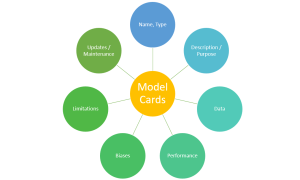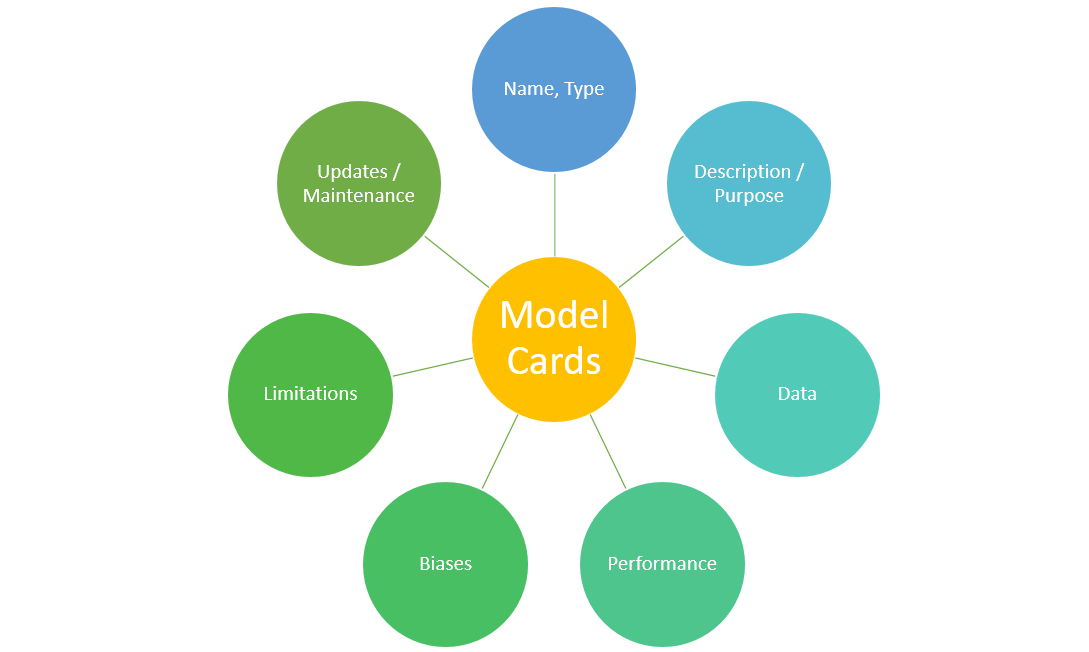
Have you ever wondered how to make your machine learning models more transparent, understandable, and accountable? Are you looking to implement responsible AI practices including ways and means to review and improve your existing model documentation? If so, you will learn about the concept of model cards, a powerful tool for documenting important details about machine learning models. You will learn the concepts with concrete examples and best practices that can serve as a guide for implementing or improving model cards in your organizations. The model card example can be seen as an standard template for model card which gets used in various different companies such as Google.
What are Model Cards?
A Model Card is a framework that provides a concise and transparent overview of a machine learning model’s capabilities, limitations, and recommended uses. It can be understood as an structured document that includes information about the model’s purpose, performance metrics, details about the training data, potential biases in the model, and more. By providing this information, Model Cards help users and stakeholders understand how a model works, how it should be used, and what its limitations are. This transparency is a key aspect of responsible AI, as it allows users to make informed decisions about whether and how to use a particular model.

One of the significant benefits of Model Cards is their potential to investigate issues like unfair bias. They can highlight disparities in model performance across diverse groups of people, encouraging developers to consider their impact from the start of the development process.
Model Cards are designed for both experts and non-experts. Developers can use them to design applications that emphasize a model’s strengths while avoiding or informing end users of its weaknesses. They can also help journalists, industry analysts, and advocacy groups better understand the impact of AI.
Here’s an example of what a model card might look like:
| Category | Details |
|---|---|
| Model Name | Sentiment Analysis Model v1.0 |
| Model Date | January 1, 2023 |
| Model Type | Supervised Learning – Text Classification |
| Model Owner | ABC Corporation |
| Model Description | This model analyzes text data and predicts the sentiment of the text as positive, negative, or neutral. |
| Model Use / Purpose | To be used for analyzing customer feedback and reviews. |
| Model Performance | Accuracy: 85%, Precision: 86% for Positive, 84% for Negative, 85% for Neutral, Recall: 87% for Positive, 83% for Negative, 86% for Neutral |
| Training Data | The model was trained on a dataset of 1 million customer reviews from various e-commerce websites. The dataset was balanced with equal numbers of positive, negative, and neutral reviews. |
| Validation Data | The model was validated on a separate dataset of 100,000 customer reviews from the same e-commerce websites. |
| Potential Biases | The model may be less accurate in predicting the sentiment of reviews that use sarcasm or complex language, as these were less common in the training data. |
| Ethical Considerations | The model should not be used to make decisions about individual customers or to penalize customers based on their feedback. |
| Recommended Uses | The model is recommended for analyzing overall trends in customer sentiment and identifying areas for improvement based on customer feedback. |
| Limitations | The model may be less accurate for text data that is significantly different from the e-commerce reviews it was trained on. For example, it may not perform well on social media posts or formal business communications. |
| Updates and Maintenance | The model will be retrained and updated quarterly to ensure it remains accurate and relevant. |
Model Cards Examples from Real World
Google has been a pioneer in using Model Cards to document their machine learning models. They introduced the concept of Model Cards in a 2018 paper – Models cards for model reporting, and have since used them for several of their models.
One notable example is Google’s use of Model Cards for their Cloud Vision API, Face Detection and Object Detection, as examples of Model Cards in action. These Model Cards provide overviews of both models’ ideal forms of input, visualize some of their key limitations, and present basic performance metrics.
Another example is OpenAI, which has used a similar approach of model card to document their GPT-3 language model. The documentation for GPT-3 includes information about the model’s capabilities, limitations, and recommended uses, similar to what would be included in a Model Card.
These examples show how Model Cards can be used to provide transparency and accountability for machine learning models, which is a key aspect of responsible AI.
Conclusion
Model Cards help achieve transparency in the world of machine learning. They are not just a tool, but a commitment to responsible AI, providing a comprehensive view of a model’s capabilities, limitations, and performance. As seen through the examples in this blog post, Model Cards can significantly enhance our understanding and utilization of AI models. They can be mandated towards achieving a transparent, accountable, and inclusive state of AI / machine learning in your organization. In order to achieve greater trust of your partners and customers, you might want to consider embracing Model Cards as a standard practice, fostering a culture of responsibility and trust in the technology.
- Coefficient of Variation in Regression Modelling: Example - November 9, 2025
- Chunking Strategies for RAG with Examples - November 2, 2025
- RAG Pipeline: 6 Steps for Creating Naive RAG App - November 1, 2025
I found it very helpful. However the differences are not too understandable for me